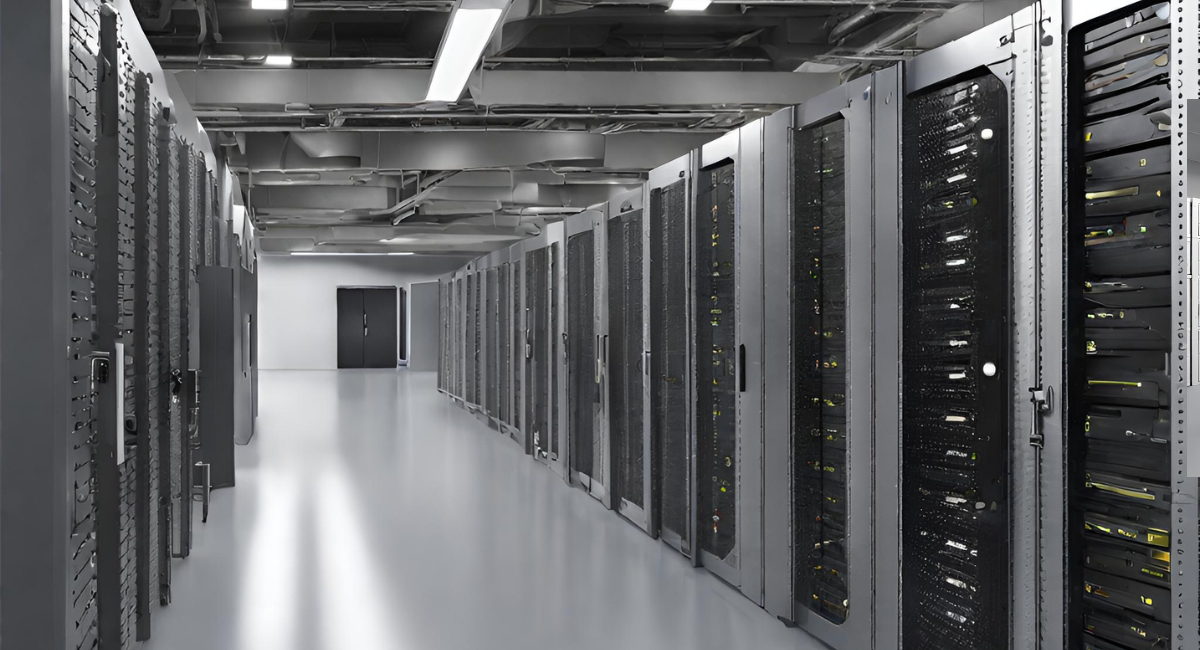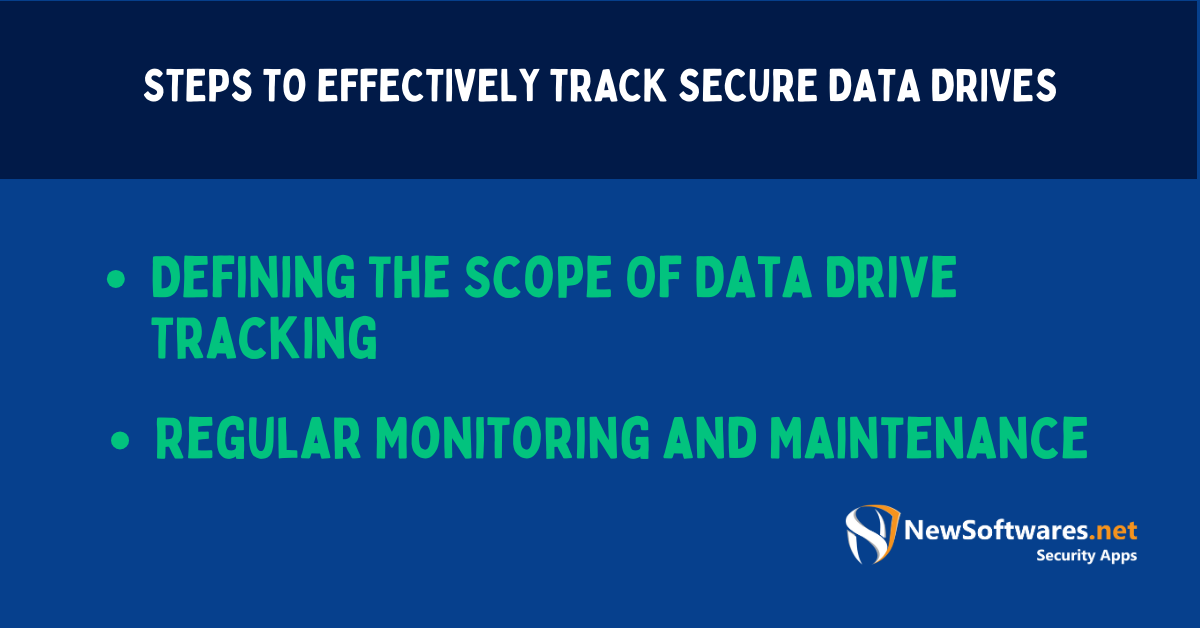To track secure data drives:
-
Use hardware solutions like secure enclosures, biometric authentication, and tamper-evident seals.
-
Implement software tools offering real-time monitoring, encryption, and alerts.
-
Regularly review access logs and conduct periodic audits.
-
Utilize advanced techniques like AI for anomaly detection and blockchain for tamper-proof tracking.
-
Employ geolocation tools and RFID tagging for physical tracking and use asset management software for inventory.
In today’s technology-driven world, the security of our precious data is of utmost importance. With the growing prevalence of cyber fears and data breaches, it has become crucial to implement effective measures to protect sensitive information. One such measure is tracking secure data drives. We will explore the importance of tracking secure data drives, the essential components for effective tracking, and steps to overcome challenges. Additionally, we will delve into advanced techniques that can be employed to boost the security of data drives.
Understanding the Importance of Tracking Secure Data Drives
Data drives play a pivotal role in maintaining the integrity and confidentiality of sensitive information. These drives safeguard valuable data, from corporate documents to personal files. Proper tracking of secure data drives ensures that access is restricted to authorized personnel and that any unauthorized attempts can be detected and mitigated promptly.
Regarding information security, data drives are a primary storage medium for individuals and organizations. They facilitate the safekeeping of important files and allow easy retrieval whenever required. As a critical component of information security, data drives are crucial in maintaining data integrity, protecting against data loss, and shielding against unauthorized access.
But why is tracking secure data drives so crucial? The answer lies in monitoring and keeping a record of data drive activities. By doing so, potential security incidents can be swiftly identified. Timely detection allows for prompt investigation and mitigation, minimizing the risk of data breaches.
Furthermore, tracking data drives helps ensure compliance with data privacy regulations, which have become increasingly stringent in recent years. Organizations must now have robust systems to track and monitor the movement and usage of secure data drives. This helps protect sensitive information but also helps maintain trust with customers, partners, and stakeholders.
Tracking secure data drives also enables organizations to have a clear audit trail of who accessed the data, when it was accessed, and for what purpose. This level of transparency not only enhances accountability but also acts as a deterrent to potential malicious activities. It sends a strong message that unauthorized access or misuse of data drives will not be tolerated.
Moreover, tracking secure data drives can lead to improved operational efficiency. By comprehensively understanding data drive usage patterns, organizations can optimize their storage infrastructure, allocate resources effectively, and identify areas where extra security measures may be required.
So, tracking secure data drives cannot be overstated. Information security is a crucial aspect that helps protect sensitive data, ensure compliance with regulations, enhance accountability, and improve operational efficiency. By implementing robust tracking mechanisms, organizations can safeguard their valued information and maintain the trust of their stakeholders.
Essential Components for Tracking Secure Data Drives
![]()
Effectively tracking secure data drives requires the right combination of hardware and software solutions. Let’s explore the essential components needed for robust data drive tracking.
Organizations must consider various hardware and software requirements when tracking secure data drives. Organizations can ensure their sensitive data’s physical and digital security by implementing the right solutions.
Hardware Requirements for Data Drive Tracking

The hardware requirements for data drive tracking can vary depending on the scale and complexity of an organization’s data storage infrastructure. Secure storage enclosures protect data drives from physical damage and unauthorized access. These enclosures provide a protective barrier around the drives, shielding them from external threats such as dust, moisture, and impact.
In addition to secure storage enclosures, robust access control mechanisms are essential for physical security. Organizations can implement biometric authentication systems, such as fingerprint scanners or facial acknowledgment technology, to ensure that only legal personnel can access the data drives. This enhances an extra layer of security, as it prevents unauthorized individuals from physically tampering with the drives.
Furthermore, utilizing tamper-evident seals and secure storage cabinets can provide added protection against unauthorized access. Tamper-evident seals are designed to show visible signs of interference, such as a broken seal or a color change, indicating that someone has attempted to gain unauthorized access to the data drives. On the other hand, secure storage cabinets are designed to resist physical attacks, making it enormously difficult for intruders to break into them.
Software Solutions for Data Drive Management
To enable comprehensive data drive tracking, organizations can utilize specialized software solutions. These software tools offer a range of features designed to enhance the security and management of data drives.
One of the key features provided by these software solutions is real-time monitoring. This allows organizations to keep track of the activities happening with their data drives in real time. Any unauthorized access attempts or suspicious activities can be detected immediately, enabling organizations to take prompt action to mitigate potential risks.
Access logs are another important feature offered by data drive management software. These logs provide a detailed record of all access attempts and activities related to the data drives. Organizations can identify patterns or anomalies that may indicate unauthorized access or potential security breaches by analyzing these logs.
In addition to real-time monitoring and access logs, software solutions for data drive management also offer activity alerts. These alerts notify organizations of any unusual activities or events, such as multiple failed login attempts or sudden changes in file permissions. By receiving these alerts, organizations can quickly respond to potential security threats and prevent unauthorized access to their data drives.
Implementing encryption and authentication mechanisms in software solutions enhances the overall security of data drives. Encryption ensures that the data stored on the drives is protected from unauthorized access, even if the physical drives are compromised. Authentication mechanisms, such as strong passwords or multi-factor authentication, safeguard that only authorized users can access the data drives through the software interface.
Effective tracking of secure data drives requires a combination of hardware and software solutions. Organizations can protect their data drives from physical threats by implementing secure storage enclosures, access control mechanisms, tamper-evident seals, and secure storage cabinets. Additionally, utilizing software solutions with features like real-time monitoring, access logs, activity alerts, encryption, and authentication mechanisms enhances the overall security and management of data drives.
Steps to Effectively Track Secure Data Drives

It is important to follow a systematic approach to establish a robust system for tracking secure data drives. Let’s discuss the steps involved in effectively tracking data drives.
Initial Setup for Data Drive Tracking
The initial setup phase involves defining the scope of data drive tracking, identifying the key stakeholders, and establishing clear policies and procedures. Designating individuals responsible for monitoring data drive activities, conducting regular audits, and promptly responding to security incidents is crucial. Adequate training and awareness programs should also be implemented to ensure the team is well-equipped to handle data drive tracking efficiently.
Regular Monitoring and Maintenance
Ongoing monitoring and maintenance are essential to track secure data drives effectively. Regularly reviewing access logs, conducting periodic audits, and analyzing system-generated reports can help identify patterns or anomalies that might indicate a security breach. By promptly addressing identified issues and implementing necessary mitigation measures, the system can be kept secure and minimize the risk of data breaches.
Overcoming Challenges in Tracking Secure Data Drives
While tracking secure data drives is vital, it has challenges. Let’s explore some common hurdles organizations face and ways to overcome them.
Dealing with Large Volumes of Data
In today’s era of big data, organizations often grapple with managing and tracking large volumes of data drives. Implementing efficient data categorization and classification mechanisms can significantly streamline the tracking process. Additionally, investing in scalable storage solutions and utilizing automated data management tools can help overcome the challenges of managing huge amounts of data.
Ensuring Data Privacy and Compliance
As data privacy regulations become increasingly stringent, organizations must comply with relevant laws and regulations. Tracking secure data drives helps meet data privacy requirements by providing an auditable trail of data access and usage. Adhering to best practices, such as data anonymization and implementing granular access controls, further enhances data privacy and compliance.
Advanced Techniques in Tracking Secure Data Drives
As technology continues to evolve, advanced techniques can be leveraged to increase the security of data drives. Let’s explore a couple of such techniques.
Leveraging AI and Machine Learning
Artificial intelligence (AI) and machine learning (ML) algorithms can examine vast data drive activity logs and identify patterns indicative of potential security threats. These algorithms can detect anomalies in real-time by continuously learning from historical data, enabling proactive security measures. Utilizing AI and ML in data drive tracking enhances security operations’ overall effectiveness and efficiency.
Utilizing Blockchain Technology for Enhanced Security
Blockchain technology offers a decentralized and tamper-proof approach to data drive tracking. By leveraging blockchain, organizations can ensure the integrity and immutability of data drive activity logs. Each record of access or modification is securely recorded in a distributed ledger, making it nearly impossible for unauthorized changes to go undetected. Integrating blockchain technology provides an additional layer of security, instilling greater confidence in the tracking process.
Key Takeaways
- Use asset management software to inventory all drives.
- Employ encryption to secure the data on drives.
- Implement geolocation tracking for the physical location.
- Conduct regular audits of drive usage and access.
- Label and barcode systems can help in manual tracking.
FAQs
Q: How can I physically track a data drive’s location?
A: Geolocation tools and RFID tagging can assist.
Q: How often should I audit my data drives?
A: Depending on sensitivity, but at least once every quarter is recommended.
Q: Is labeling a good practice for data drives?
A: Yes, but ensure labels don’t give away sensitive information.
Q: What if a data drive goes missing?
A: Trigger protocols like remote wipe (if applicable) and start an internal investigation.
Q: Can I remotely manage data on a drive?
A: Some drives come with software that allows remote management and wipe capabilities.
Conclusion
In conclusion, tracking secure data drives plays a vital role in safeguarding sensitive information and mitigating the risk of data breaches. Organizations can enhance the security of their data drives by understanding the importance of data drive tracking, implementing the essential components, following systematic steps, overcoming challenges, and embracing advanced techniques. As technology evolves, staying updated with the newest trends and best practices will be crucial in ensuring the ongoing protection of valuable data.
